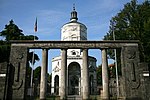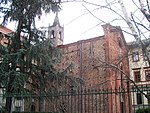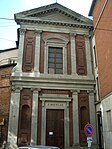Basilica of Sant'Ambrogio
1099 establishments in Europe11th-century Roman Catholic church buildings in Italy11th-century establishments in ItalyBasilica churches in MilanBurial sites of the Herbertien dynasty ... and 8 more
Church frescos in ItalyChurches completed in 1099Coronation church buildingsPalaeo-Christian architecture in ItalyRomanesque architecture in MilanRuins of churches destroyed during World War IITourist attractions in MilanUse American English from August 2021

The Basilica of Sant'Ambrogio (official name: Basilica romana minore collegiata abbaziale prepositurale di Sant'Ambrogio) is a church in the center of Milan, northern Italy.
Excerpt from the Wikipedia article Basilica of Sant'Ambrogio (License: CC BY-SA 3.0, Authors, Images).Basilica of Sant'Ambrogio
Piazza Sant'Ambrogio, Milan Municipio 1
Geographical coordinates (GPS) Address External links Nearby Places Show on map
Geographical coordinates (GPS)
| Latitude | Longitude |
|---|---|
| N 45.462425 ° | E 9.1758055555556 ° |
Address
Basilica di Sant'Ambrogio
Piazza Sant'Ambrogio
20123 Milan, Municipio 1
Lombardy, Italy
Open on Google Maps










